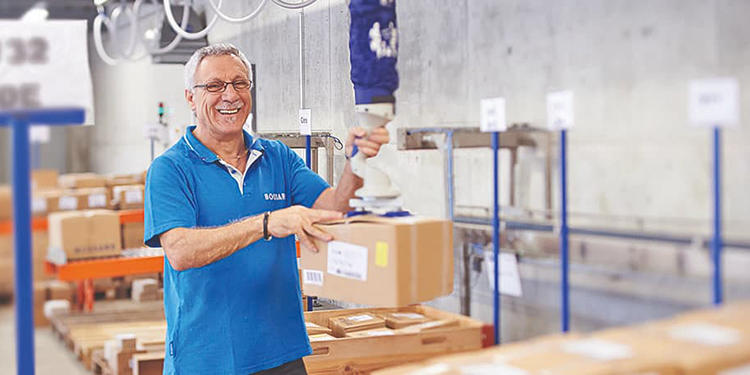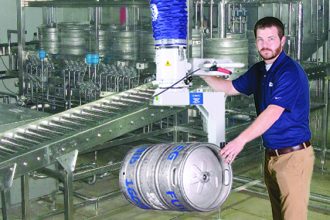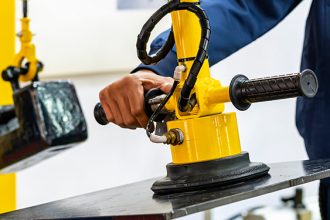
According to the Occupational Health and Safety Administration (OSHA) and the Bureau of Labor Statistics, among its Top 10 most common causes of workplace injuries in 2020 overexertion was fourth, followed by repetitive motion at fifth. With both of these types of injuries related to either a single incident or the cumulative effect of employees manually pulling, lifting, pushing, holding, or carrying loads, companies across a wide range of industries are beginning to take a closer look at providing lift assist devices to improve worker ergonomics. Implementing technologies such as vacuum lifters, intelligent lifting devices, and workstation cranes can all help employees to avoid physical harm, including lower back injuries and chronic joint pain.
Additionally, with the 32.4% increase in U.S. e-commerce in 2020 — resulting from the COVID-19 pandemic — paired with the continued labor shortage, warehouses and distribution centers in nearly every industry are struggling to maintain throughput rates with fewer workers. It has, therefore, become even more important to deploy lift assist devices that help operators remain both safe and efficient. Companies who utilize such technologies benefit from:
- Increased productivity: Employees can lift more loads without slowing down. The last lift of the day is just as quick and safe as the first lift of the day. Additionally, for operations that rely on temporary labor to help keep pace with customer demands, these devices make it easy for new staffers to learn how to properly perform a job.
- Healthier employees: By reducing injuries associated with heavy and repetitive tasks, employees are ready to work every day and not out on worker’s comp. Further, with lift assist devices, team lifts can be eliminated. This allows employees to remain socially distant as one person can now accomplish a two-person lift.
- Added flexibility: Strength and body type — big and muscular or small and slender — no longer matter in terms of an employee’s ability to perform a lifting or transporting task when an ergonomic lift assist device is at their disposal. This enables anyone to be assigned a job, increasing workforce flexibility.
Multiple industries would benefit from the implementation of ergonomic lift assist devices in their operations. Three sectors in particular that are facing the twin challenges of rising consumer demand and a lack of available workforce include:
Warehousing and Logistics – Since the start of 2020, more than 75% of American companies have suffered pandemic-related supply chain disruptions, such as decreased availability of products, extended lead times, and order cancellations. By redesigning handling processes and implementing more flexibility through ergonomic lift assist devices, companies can increase their resiliency. In addition to cutting the number of necessary team lifts and increasing social distancing compliance, warehousing, logistics, and third-party logistics (3PL) service providers can make training of lifting tasks faster and easier, as well as available to be performed by a larger percentage of their existing workforce.
Food and Beverage – Companies that produce, process, and deliver food to consumers have a variety of handling tasks that can only be performed by a small percentage of the workforce. Among them: filling, palletizing, depalletizing, and dumping 50-pound bags of ingredients, such as flour or sugar, and other ingredients. Other complex handling tasks include flipping kegs after filling to stack them; lifting blocks of product like meat, cheese, and butter; and palletizing finished products in a variety of packaging forms — such as boxes, bags, or drums — for shipping. With ergonomic lift assist devices, anyone within the operation can easily perform these tasks with minimal risk of injury.
Pharmaceuticals – Manufacturers and distributors of pharmaceuticals and drug ingredients also must handle a range of product formats, including bags, drums, and boxes. Further, their equipment is often subject to stringent requirements, such as the ability to withstand high-temperature washdowns and provide explosion-proof operation. There are a variety of ergonomic lift assist devices that have been engineered specifically to deliver the same injury reduction and productivity boosting benefits in these sensitive environments, including those with stainless steel construction and pneumatic power sources.
Regardless of the industry or handling application, there are a variety of ergonomic lift assist solutions available to help minimize the risk of workplace injuries associated with overexertion and repetitive stress. To help operations find the right technology for their unique process, the members of Ergonomic Assist Systems & Equipment (EASE) offer a free publication, “Ergonomic Guidelines for Manual Material Handling.”



